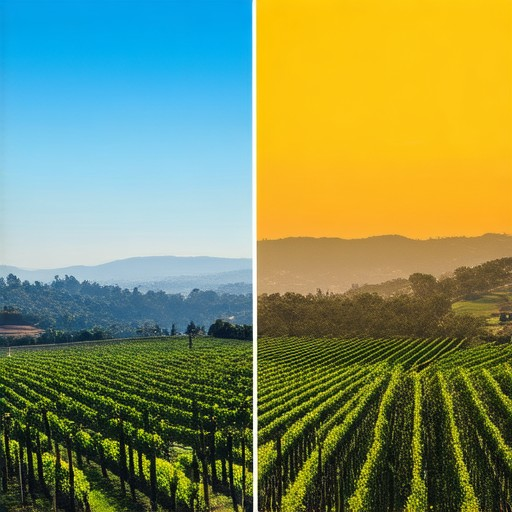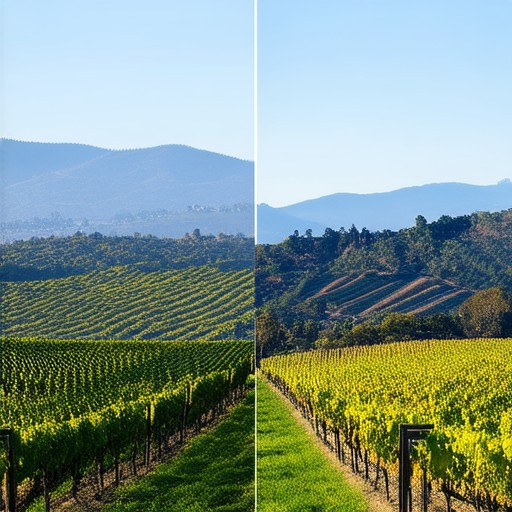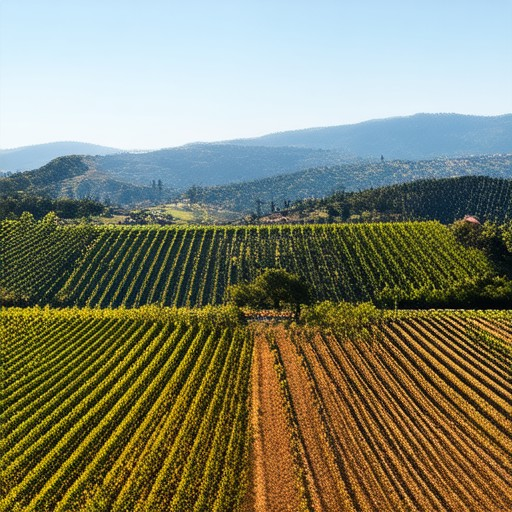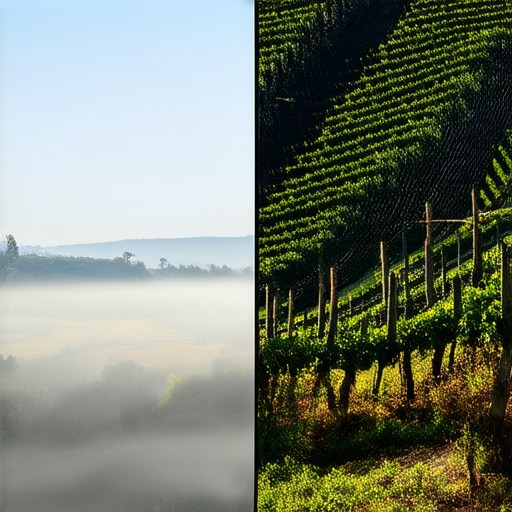When planning a visit to California’s renowned wine country, few destinations captivate as much as the neighboring regions of Napa and Sonoma. Renowned for their world-class viticulture and iconic wineries, both Napa and Sonoma offer unparalleled opportunities to explore some of the finest wine regions in the United States. Whether you’re a casual wine enthusiast or a seasoned connoisseur, the diverse landscapes and rich histories of these two areas provide a fascinating glimpse into the artistry of winemaking. From the rolling hills of Napa Valley to the charming countryside of Sonoma County, each region offers its own unique charm and culinary delights. This guide delves into the differences between these two celebrated wine regions, offering insights into their wineries, wine styles, and the best ways to enjoy them during your next trip to wine country.
Key Takeaways
– Napa Valley Wines Are Renowned for Their Premium Quality and High Expense: Napa Valley is famous for producing some of the most luxurious and costly wines, particularly Cabernet Sauvignon and Chardonnay.
– Sonoma County Offers More Affordable Wine Options: Sonoma County provides a wider range of moderately priced wines, making it accessible to a broader audience.
– Sonoma Excels in Diverse Wine Varieties: The region is known for Zinfandel, Pinot Noir, Sparkling Wines, and Unoaked Chardonnays, offering unique flavors.
– Climate Shapes Wine Characteristics: Napa’s warmer climate favors bold reds, while Sonoma’s cooler environment supports aromatic whites and structured reds.
– Sonoma Has a Higher Concentration of Family-Owned Wineries: With more small, boutique producers, Sonoma offers a richer tasting experience.

Wine Regions in Sonoma Valley
Sonoma Valley is home to several American Viticultural Areas (AVAs), each known for its unique terroir and grape-growing conditions. Here’s a breakdown of the primary wine regions in Sonoma Valley:
- Alexander Valley : Known for its rich, red wine production, particularly Cabernet Sauvignon and Merlot.
- Bennett Valley : A smaller appellation noted for its cool climate and high-quality red wines.
- Carneros : Famous for its Burgundian-style wines, Carneros is known for Pinot Noir and Chardonnay.
- Chalk Hill : Renowned for its white wines, particularly Chardonnay, due to its chalky soil.
- Dry Creek Valley : Best known for Zinfandel, this region offers bold, fruit-forward reds.
- Fort Ross-Seaview : Located in the western foothills, this area is celebrated for its high-quality Pinot Noir.
- Fountaingrove District : Known for its diverse soils and a mix of red and white wines.
- Green Valley of the Russian River Valley : Specializing in Chardonnay, this region is known for its crisp, clean whites.
- Knights Valley : A relatively newer AVA, Knights Valley is recognized for its Cabernet Sauvignon and Merlot.
- Moon Mountain : A recent addition, this AVA focuses on mountainous terroir and premium red wines.
- Northern Sonoma : Encompasses a variety of smaller appellations, including some of the county’s most historic wine regions.
- Petaluma Gap : Part of the larger Sonoma region, Petaluma Gap is known for its unique microclimates.
- Pine Mountain-Cloverdale Peak : Located at higher elevations, this area is ideal for cool-climate wines.
- Rockpile : A small, premium AVA known for its steep slopes and exceptional red wines.
- Russian River Valley : One of the largest AVAs in California, known for its diverse soils and varied wine styles.
Choosing Between Sonoma and Napa
When deciding whether to stay in Sonoma or Napa, it’s essential to consider your preferences and what you’re looking to get out of your trip. Both destinations offer exceptional wine, food, and natural beauty, but they cater to different types of experiences.
When to Choose Sonoma
- If you prefer a more laid-back atmosphere and smaller crowds.
- If you’re seeking a mix of fine dining and casual eateries.
- If you enjoy exploring charming towns and historic sites.
- If you want a variety of accommodation options, including boutique hotels and bed-and-breakfasts.
- If you desire a more personal and less commercialized experience.
When to Choose Napa
- If you’re looking for a luxury travel experience with high-end resorts and spas.
- If you want to visit iconic wineries and celebrity chef restaurants.
- If you appreciate a vibrant culinary scene and upscale shopping.
- If you enjoy a mix of urban amenities and outdoor adventures.
- If you’re planning a romantic getaway or a special occasion.
Additional Considerations
- Both destinations require a car for optimal exploration.
- Sonoma may offer more affordable accommodations compared to Napa.
- Napa tends to be busier and more tourist-heavy, while Sonoma maintains a quieter, community-focused vibe.
Final Recommendation
For a balanced mix of relaxation and luxury, Sonoma is an excellent choice. It provides a diverse range of activities and dining options without the intensity of Napa. However, if you’re aiming for an upscale, high-profile experience, Napa will deliver on that front.
Ultimately, your decision should align with what you value most during your stay in California’s wine country.

Napa Valley Wine Regions
Napa Valley, located in California, is renowned for its diverse wine-producing regions. Below is a breakdown of the major and nested American Viticultural Areas (AVAs) within Napa Valley:
- Main Napa Valley AVA : This is the overarching region that encompasses the entire Napa Valley.
- Atlas Peak AVA : Known for its high elevation and rugged terrain, producing powerful reds and whites.
- Calistoga AVA : Located in the southern part of Napa Valley, characterized by its warm climate and rich soils.
- Chiles Valley AVA : A cooler climate region ideal for growing Burgundian varieties like Chardonnay and Pinot Noir.
- Coombsville AVA : A small, hillside region with a unique microclimate, known for its Cabernet Sauvignon production.
- Crystal Springs AVA : Located near the Napa River, this region benefits from maritime influences, producing elegant wines.
- Diamond Mountain District AVA : A mountainous area with limited plantings, yielding high-quality, age-worthy wines.
- Howell Mountain AVA : Situated along the eastern mountains, this region is known for its steep slopes and full-bodied reds.
- Los Carneros AVA : A cool, coastal-influenced region that produces some of the valley’s finest sparkling wines.
- Mt. Veeder AVA : A high-elevation area with diverse soils, producing a range of wine styles from crisp whites to bold reds.
- Oak Knoll District AVA : Characterized by well-drained soils, this region is noted for its Merlot and Cabernet Sauvignon.
- Oakville AVA : Home to some of Napa Valley’s most famous wineries, this area is known for its versatility in wine production.
- Rutherford AVA : Located in the heart of Napa Valley, this region is celebrated for its Bordeaux-style blends.
- St. Helena AVA : A historic wine-growing region, known for its elegant white wines and robust reds.
Each of these regions contributes uniquely to the overall character of Napa Valley’s wine scene, offering a diverse range of terroirs and wine profiles. Explore more about each AVA and their unique characteristics by visiting our in-depth guide .

Napa vs. Sonoma Wines: What’s the Difference?
The world of wine can be overwhelming, especially when trying to decide between two iconic regions: Napa Valley and Sonoma County. While both are part of California’s renowned wine country, they have distinct characteristics that set them apart. Here’s a breakdown of the key differences:
- Price Point: Napa Valley is often associated with premium wines, with prices typically reflecting the high demand and limited supply of its grapes. Sonoma County, while still producing excellent wines, tends to offer more moderate pricing, making it accessible to a broader audience.
- Varied Offerings: Napa Valley is famous for its Cabernet Sauvignon, Chardonnay, and Merlot wines, which are often large, rich, and age-worthy. Sonoma County, on the other hand, excels in producing a wider variety of wines, including Zinfandel, Pinot Noir, Sparkling Wines, and Red Blends. Sonoma also has a strong reputation for unoaked, zesty Chardonnays.
- Climate & Soil: Both regions benefit from ideal growing conditions, but Napa’s warmer climate and alluvial soils are particularly suited for big, bold reds. Sonoma’s cooler climate and diverse terrain allow for a mix of aromatic whites and structured reds.
- Diversity of Wineries: Sonoma County boasts a larger number of small, family-owned wineries compared to Napa, which has more large-scale producers. This diversity means visitors to Sonoma can explore a greater range of unique wineries and tasting experiences.
Whether you’re looking for opulent Napa Valley wines or exploring the diverse offerings of Sonoma County, both regions offer something truly special. For a deeper dive into the world of wine, visit our wine region guides to learn more about the wineries and varietals in these iconic areas.
What is the Most Famous Winery in Sonoma?
Sonoma County, California, is renowned for its world-class wine production, and among its many celebrated wineries, Buena Vista Winery stands out as one of the oldest and most iconic. Established in 1857 by Count Agoston Haraszthy, it is often hailed as the birthplace of California’s modern wine industry.
However, Sonoma is home to several other legendary wineries that have made significant contributions to the region’s wine culture:
- Castello di Amorosa – Known for its striking castle-like structure, this winery produces exceptional reds and whites, including its famous Dominus Estate .
- Opus One Wines – Renowned for its opulent tasting rooms and iconic wine labels, Opus One offers some of the most sought-after Napa Valley blends.
- Frog’s Leap Winery – A leader in sustainable viticulture, Frog’s Leap is famous for its “Leapfrog” wine program and innovative farming techniques.
- Stag’s Leap Wine Cellars – Celebrated for its rich history and bold reds, Stag’s Leap consistently delivers wines that rival those from Europe’s top regions.
Each of these wineries contributes uniquely to Sonoma’s reputation as a premier wine destination. Whether you’re a casual wine enthusiast or a serious collector, exploring these iconic estates promises a memorable experience.
For a truly personalized visit, consider planning a trip to Sonoma to tour these legendary wineries and immerse yourself in the region’s rich viticultural heritage.

Napa vs. Sonoma Wine Pricing Comparison
When comparing the cost of wines from Napa Valley and Sonoma County, it’s important to understand that several factors influence the price differences.
Reputation and Prestige
Napa Valley is renowned for producing some of the world’s most exclusive and expensive wines. Its history of high-quality wine production and association with luxury brands contribute to higher prices. Many Napa wines, particularly those from iconic valleys like Stag’s Leap and Rutherford, often fetch premium prices due to their prestige and limited supply.
Cost of Living and Winemaking
The high cost of living in Napa Valley significantly impacts wine prices. Expensive land and production costs, coupled with the demand for premium wines, result in higher prices. In contrast, Sonoma County, while also a top wine-producing region, may offer more affordable options due to lower overall costs, though this can vary depending on the specific winery and appellation.
Grape Variety and Production
Both regions grow a variety of grape varieties, but Napa Valley tends to specialize in Bordeaux blends and Burgundy-style wines, which are often more expensive. Sonoma County offers a diverse range, including Zinfandel and Chardonnay, which may be priced differently based on demand and winemaking techniques.
Tourism and Market Demand
Napa Valley attracts a higher concentration of luxury seekers, leading to wines that are priced at the premium end of the market. Sonoma County, while equally renowned, may cater to a broader audience, resulting in more moderately priced wines that still deliver exceptional quality.
Examples and Exceptions
For instance, a bottle from a top Napa winery like Opus One can exceed $100, whereas a comparable Sonoma wine might range between $80 and $90. However, it’s essential to note that some Sonoma wineries, particularly in appellations like Knights’ Valley, also produce extremely high-end, expensive wines.
Conclusion
In general, Napa Valley wines are more expensive than those from Sonoma County. However, this is not a strict rule, as there are exceptions, especially among top-tier Sonoma offerings. The choice between the two ultimately depends on personal preference, budget, and the specific wine style you’re seeking.
Learn more about wine regions and their unique characteristics .



0 Comments